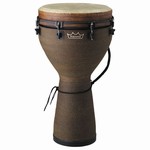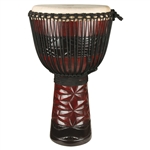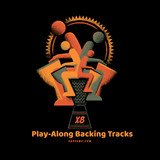Key Tuned vs. Rope Tuned Djembe
There are essentially two types of tuning systems found on most djembe drums - key tuned and rope tuned. To help you make a more informed decision when selecting your new djembe, I will discuss each type of tuning system and touch upon some of the differences.
Key tuned djembe drums tend to have a more modern feel and are tuned using a wrench to tighten the bolts around the djembe head. They are also known as 'mechanically tuned' or 'bolt tuned'. The distinguishing feature of key tuned djembes is a bulky, metal rim that fits around the head and is secured to the body using metal tuning hooks. The additional hardware on this type of djembe adds weight and is a bit of an eyesore. The trade-off in aesthetics is a tuning system that is relatively easy to understand. Just grab the wrench and begin tightening the bolts found on each tuning hook as you go around the head. Tightening the bolts will tighten the skin thus pitching up your djembe head.
Rope tuned djembes are more traditional in their design and are tuned by tightening the ropes around the head of the djembe. Depending on the djembe, there are either two or three metal rings fitted around the head of the drum. However, unlike mechanically tuned djembe drums where there is a most prominent metal rim wrapping around the djembe; the metal rings of rope-tuned djembes are tucked under the skin, are much thinner and not very noticeable.
Additionally instead of the tuning hooks, as found on mechanically tuned djembes, rope tuned djembes are fitted with a bunch of vertical rope runners that run up and down the bowl. These vertical rope runners are fastened to the metal rings around the djembe head and are used to place tension on the skin when pulled tightly. To tune the drum you would place horizontal knots on the various sets of vertical rope runners by pulling what's called a diamond. This is known as the Mali Weave. Tuning a rope based djembe can be done quite confidently by a beginner and doesn't take long.
Making a determination of whether or not to go with a mechanically tuned djembe or rope tuned djembe is really a matter of personal taste. However, it's probably safe to say that most players today are choosing rope based djembes due to their traditional aesthetic appeal, and better sound quality. Djembes that are fitted with a mechanical tuning system just seem to lack that "real" djembe sound. Additionally, I've found the bulkiness of the mechanical rim to get in the way of playing.
X8 Drums Djembe Buying Guide
2. Djembe Wood Source & Lathing [Video]
3. Djembe Shell Carving & Painting [Video]
5. Which Size Djembe is Right for Me? [Video]
6. Key Tuned vs. Rope Tuned Djembe
7. Djembe Drum: Wood vs. Synthetic
8. How to Tune a Djembe [Video]
10. A Note About African Djembes
11. Djembe Rhythms and Exercises [Video]
12. Djembe Rope. Why Quality Matters.
13. Taking Care of your Djembe
15. How to Play the Djembe [Video]
16. Play the Djembe is Easy for All!
Recent Posts
-
X8 Drums Play-Along Backing Tracks
The new X8 Play-Along Series is being produced for our musician friends wanting a fresh way to work …9th Feb 2025 -
What is the Best Size Djembe for Beginners?
If you're new to the world of percussion and interested in learning the djembe, you're in for a t …16th Jul 2024 -
The Benefits of Becoming a Drumming Teacher: Transforming Passion into Profession
Why become a drumming teacher? Becoming a drumming teacher is an excellent way to share your pas …22nd May 2024





